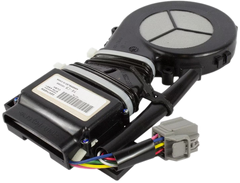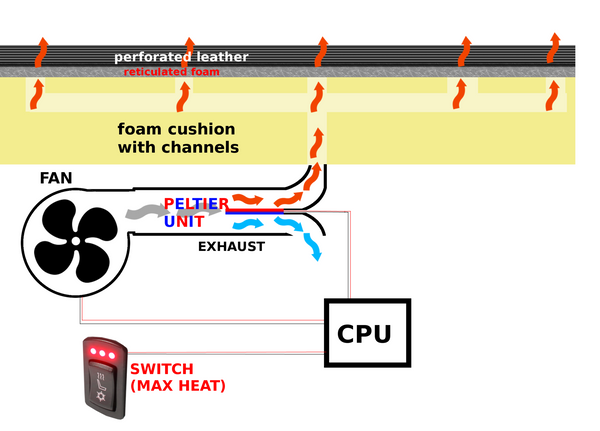If you got to this page, you're looking for information and wondering how the air conditioned seats in your car, truck, or SUV work. I was curious also years ago, when they first were introduced in 2000 by Lincoln in their Navigator. The internal workings of the air conditioned seats are very complicated. The photo below depicts an old schematic I found online. If you're laughing by now.....just keep reading.

The Truth Behind Seat Cooling
At first I was told it was a system of tubing in the seats hooked up to the vehicles air condition system, as seen in the photo above. After some thought, I decided to to research it further, as you are doing today. The tubing system with R134a Freon refrigerant connected to the vehicles air conditioning system just didn't seem safe , especially in a car or truck seat. Obviously I got bad information, IT DEFINITELY WASN'T SAFE AND SURELY NOT TRUE.
Believe it or not, many people think that's how car seats are air conditioned. This is because there are so many misguided articles and blogs on the internet talking about refrigerant, condensers and compressors, it is all rubbish, these articles and blogs are all a fugazi. We at OEM SEATS have never, ever, EVER received a seat that had any freon tubes within the seat or outside the seat to connect to the cars air conditioning system. Since we are the authority of seat sales, with thousands of OEM Seats passing through our warehouse yearly. I promise that if I ever see any freon tubing hanging on the bottom of a seat, I will immediately revise this article.
After more research on Google in 2001, I saw an article that basically said there was duct work sucking up the cold air from the vehicles heat and air conditioned piping system for your rear passengers. A fan under the seat distributes this air through the perforated holes in the leather seats. Well, THAT WAS WRONG TOO! But remember this paragraph as it will be important later in this article.
Also note: many links in this article will be the technical data and complicated information, if you wish to peruse it. However, it is definitely too complicated for me. So this article will remain just about the basics of Air Conditioned Seats.
How Do Air Conditioned Seats Work?
Air conditioned vehicle seats use a Peltier (pronounced [PEL] + [TEE] + [AY] ) Unit or thermoelectric device, to actively cool ambient air from the vehicle and blow it through air channels in the seat. This thermoelectric (TED) unit utilizes the Peltier Effect, cooling air up to 20 degrees. This is the TED Unit it measures 2 inches by 2 inches. When you add power to it, one side gets so cold that if you add a drop of water, it will immediately freeze. The other side will get so hot it will burn you. When you flip the positive (red) and negative (black), which is changing the Polarity, the opposite happens.
 This complete TED unit as seen below contains the fan, the Peltier cold and hot unit (seen above), the safety sensors, the heat sink fins, all wrapped up in a black plastic housing.
This complete TED unit as seen below contains the fan, the Peltier cold and hot unit (seen above), the safety sensors, the heat sink fins, all wrapped up in a black plastic housing.Lets go off on a important tangent note. See the round part of the fan housing, that light gray area is a screen mesh air filter. If you have air conditioned seats already but the air doesn't flow out of your perforated leather holes like it used to. That screen air filter may be clogged and needs to be cleaned, some car manufactures have a removable screen filter and you can just replace them. If you don't have a removable filter like the one below, a toothbrush will do the trick. OK, back to the Peltier TED explanation!
How Do Seat Coolers Work?

The Peltier unit features 2-sides. One side of the unit gets hot and one side gets ice cold. Air passes over the Peltier unit from the fan, that's the round part in the photo above, and is split into two streams. One stream of the desired temperature air gets blown into the seat and through some creative duct work, into a distribution pad layer called Reticulated Foam. After the air passes through the Reticulated Foam it comes out of the perforated holes in your leather seats, either hot or cold. The other stream of air is the waste or exhaust air. Here are some basic photos below showing the seat heating and cooling diagrams.
True air conditioned seats can both heat and cool using the same system. The TED Device by changing the polarity will either heat or cool.
Below: Air coming from the fan is gray ambient air, after it hits the Peltier unit the red hot air is blown through your perforated leather and the ice cold blue air is exhausted out under your seat.
Heated & Cooled Seats - Heating Mode Diagram
Heated & Cooled Seats - Cooling Mode Diagram
That stream of waste or exhaust air gets pushed underneath the seat. The switch and computer (ECU or CPU) dictate both the fan speed (voltage), the hot/cold layout of the Peltier (polarity), and the intensity of the Peltier heating/cooling effect (voltage). In addition to what's shown in the illustration below there are also numerous safety sensors measuring temperature of the system throughout. The CPU(computer) takes care of the polarity switching (hot or cold), fan speeds, and safety sensors. The sensors make sure that the Peltier unit doesn't overheat and fail. That repair can get quite expensive.
Now that you know the basics of how air conditioned(cooled) and heated seats work, next is a basic layout of an air conditioned seat in its entirety.
Truly air conditioned (cooled) seats have become the gold standard in seating comfort. If you are wondering, Amerigon was the company to first design the seats.
How To Add Cooled Seats To a Car
Absolutely! There are a few different ways to do this. The route you go is very much dependent on what you have now and what your vehicles manufacturer offered. If your vehicle never offered cooled seats you have no choice but to go with aftermarket.
If your manufacturer did have an air conditioned seat option available for your vehicle then the easiest route is often times just finding a used seat that has the option. If you can get your hands on that seat then the last bridge to cross is wiring it up!
Install OEM Seats with Heated & Cooled Seat Wiring Kits
We offer simple 12 volt installation kits for many of the most common Peltier-cooled seats. These allow you to install your seats without having to worry about connecting them to the brains of your car. Our standalone kit utilizes all OEM safety features for temperature control.
Add Aftermarket Air Conditioning To Your Seats
Modifying a seat to have true air conditioning can be through Katzkin using their Degreez System. This can only be done by trained professionals. This kit costs anywhere from $600 to $1000 per seat at the average upholstery shop.
How Do Ventilated Seats Work?
Remember in the beginning of this article when I wrote: "But remember this paragraph as it will be important later in this article?" In the last 4 or 5 years, the car, truck and SUV manufacturers came up with a new term, Ventilated Seats. See the photo below, and remember gray is just the temperature in your vehicles cabin.

These ventilated seats are simply a fan, under your seat blowing the vehicles ambient air temperature through your perforated leather holes and a series of air channels in the seat.
Can You Add Ventilated Seats To a Car?
If your vehicle was offered by the manufacturer with ventilated seats then you're in luck. What these systems lack in performance they make up for in simplicity. You can typically retrofit fan-only ventilated seats into your vehicle with some light electrical modifications typically involving a rheostat or variable voltage switch.
How Do Heated Seats Work?
Heated seats use a thin heating pad underneath the seat cover to warm the seat. Some manufacturers offer separate controls for the leanback and cushion heaters. Certain manufacturers are utilizing heater pads that allow air to pass through to make room for ventilated seats.
The Race To The Bottom
Thanks to the "thrifty" folks at the auto manufacturers, more "cost efficient" solutions to heating & cooling have been devised since the advent of peltier cooling! This alternative method employs a resistance wire heater to handle the heating - the heating pad is made of a special foam that allows air to pass through similarly to reticulated foam! We've seen this style in everything from Cadillac to Kia! Thankfully, these systems suck up the coldest air from the vehicle so they're no longer as complicated. There is a performance loss, but it's not quite the 20 degree difference you'd expect when checking technical documents.
Know What You're Buying
So when buying a newer vehicle, make sure your seats are cooled or air conditioned and not just ventilated. I hope this article helped you understand the basics of air conditioned Seats and how they work. So on your next vehicle purchase at the dealership, it will not result in you getting duped by a salesman on the difference between ventilated seats and cooled Seats. You simply have to ask him if these seats have a Peltier unit or just a fan....First he will start stuttering, then you can watch his head explode. Enjoy the Knowledge!
